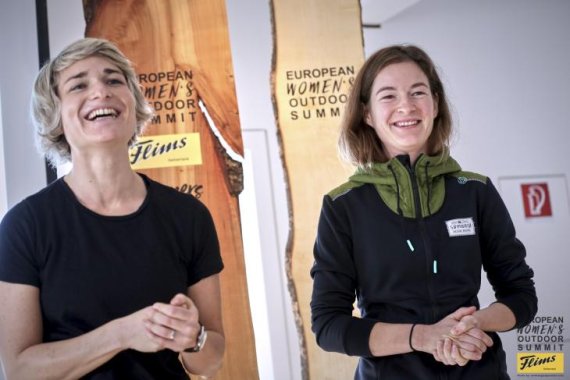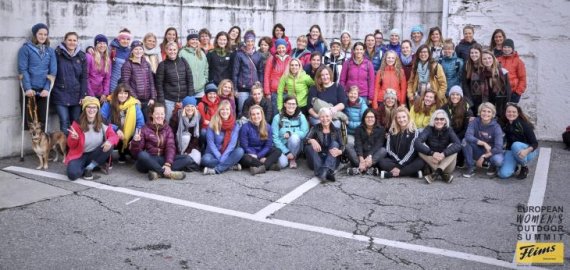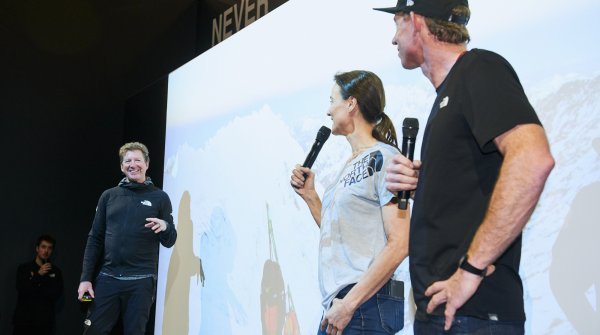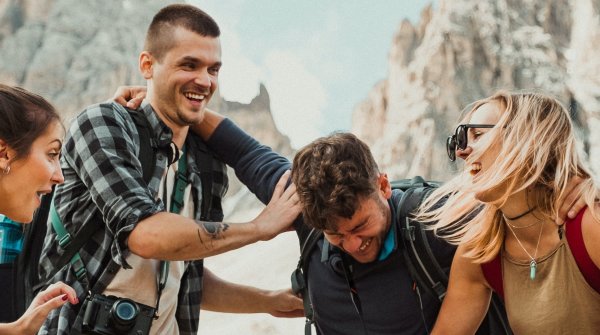“For me, it’s not about equality, but I would like the option to do the same thing,” says Sandra Lahnsteiner, freeriding pro and filmmaker. The Austrian citizen is the maker of the ‘Shades of Winter’ films. Exclusively female freeriders are featured: an absolutely exceptional case in male-dominated outdoor and action sports films. In general, women play a secondary role in the outdoor industry. But that’s been changing for a couple of years.
Mountain biking editors Anna Weiß and Hannah Röther invited over 60 women from the outdoor industry to Flims/Laax for the 1st European Women’s Outdoor Summit to talk about participation, shares, and visibility of women in the outdoor market.
Weiß and Röther also want to establish a cross-sport platform for female outdoor athletes with bloomers-outdoors (starts May 2018). “During my time as editor for the ‘World of Mountain Biking’ magazine, I got plenty annoyed about “women’s products” ,” says Weiß on her motivation for the platform and summit.
The complexity of the topic became apparent in the perspectives of the readers and the discussions at the summit. The industry is encouraged to evolve further in four sectors.
“In the best case, there’s the same product for women with a different label. In most cases, it’s more difficult and not as well outfitted/designed, but more expensive,” says Weiß. Even the female riders on the MTB team would prefer to ride the unisex product than the women’s version.
Even Irmgard Beck, designer for functional sportswear and speaker at the summit, agrees with her on this: “The prettification, the marketing should take a bit of a backseat. Women should be taken more seriously.” And so Beck asks herself, for instance, why in many collections for women there’s a limited selection of softshell jackets. And yet, at the same time, there are no “cozy items” for men.

Beck has 30 years of industry experience and has already worked for several renowned sports brands. Her advice: “The industry should listen to women more. And when they want to communicate with women, it’s often with soft voices.”
What would otherwise be important for her would be men and women being represented in equal number in (design) teams.
Another experience Beck’s had and that many product developers and designers can confirm: Painstakingly elaborate and innovative product designs often fail at the last decision-making body in upper management. Usually only men are represented here.
Then developments aren’t implemented because their necessity isn’t recognized, especially in women’s products. Instead, as the designer’s experience shows, the tried and trusted are just produced in different colors. Even valuable input, from female athletes for example, gets lost. The requirement that results for her: more women in leadership positions.
A study with nearly 22,000 companies agrees with her: The Peterson Institute for International Economics has found that a 30 percent higher proportion of women in head positions results in a 15 percent higher net revenue.
“82 percent of women don’t have a favorite sports store, as opposed to the fashion sector,” says Ulrike Luckmann. She did some surveys on the subject. A good shopping atmosphere is incredibly important, however, as women wouldn’t just purchase with a purpose, but enjoy shopping – without a defined goal.
Studies show that women are responsible for the majority of private consumer decisions. Outdoor retail is missing out on this opportunity. Designer Irmgard Beck is also of the opinion that shops aren’t brave enough when it comes to new collections. “Retail is an additional bottleneck here,” says Beck. The brave, innovative pieces from a collection usually don’t get ordered.

In ad campaigns, in self-representation in catalogues, or on websites, women have long since been completely neglected. Some things have already changed here But many people from the industry believe that the female target group is still being perceived as a “project.”
Sophie Knechtl is a sports scientist. She’s familiar with several studies on the subject of female athletes in the media, which clearly show: “Women are not just underrepresented. There’s also a gender stereotyped representation.” Female athletes are thus often belittled, or their achievements trivialized and infantilized.
In men it’s the performance that counts, but with women it’s more about appearance and staging. MTB endurance pro Ines Thoma therefore wishes that women could just be themselves: “Not everybody thinks that a woman can’t paint her nails or she’s too stereotypical. Or that a woman has to paint her nails to fit a cliché.”
The fact that different standards apply for women than for men makes itself incredibly apparent in sponsorship,” says Thoma. The prize money and the race courses are identical at the Enduro World Series (EWS), but what’s different is the sponsorship. The top ten male riders earned six-figure amounts in a year.
“I estimate that we women get a quarter as much, maximum,” says Thoma. Her EWS pro colleague, Caro Gehrig, agrees: “With the men, it’s cool when they’re crazy on the track. With us woman, it’s often so trivialized. I think that performance is performance, and it speaks for itself.”
The mountain biker wishes that more would be invested in the top. This is also important for establishing role models. Then, other girls and women could get inspired, too.
GoPro has also recognized this problem, according to Jennifer Long, Production Coordinator at GoPro. Of 197 athletes at GoPro, only 27 are women. On top of that, two thirds of GoPro owners in Germany are male. “GoPro is working on changing this,” says Long. “We want to amplify our female customer base. That is very important for us.” Some companies could have this goal in 2018.

 OutDoor by ISPOOutDoor in transition
OutDoor by ISPOOutDoor in transition
- Awards
- Mountain sports
- Bike
- Fitness
- Health
- ISPO Munich
- Running
- Brands
- Sustainability
- Olympia
- OutDoor
- Promotion
- Sports Business
- Textrends
- Triathlon
- Water sports
- Winter sports
- eSports
- SportsTech
- OutDoor by ISPO
- Heroes
- Transformation
- Sport Fashion
- Urban Culture
- Challenges of a CEO
- Trade fairs
- Sports
- Find the Balance
- Product reviews
- Newsletter Exclusive Area
- Magazine





